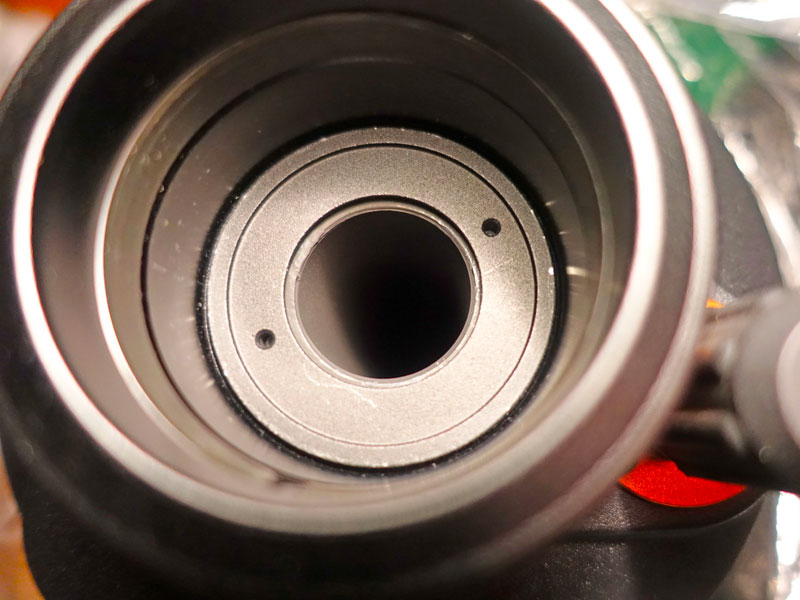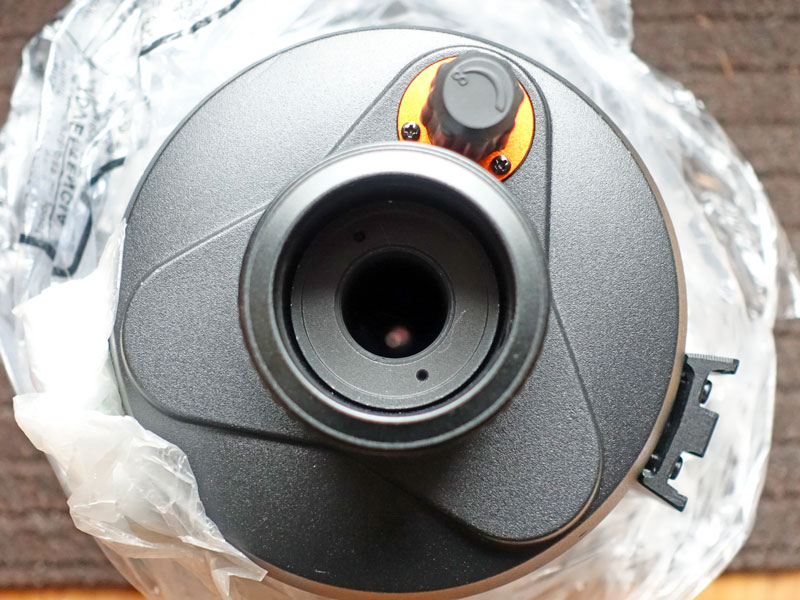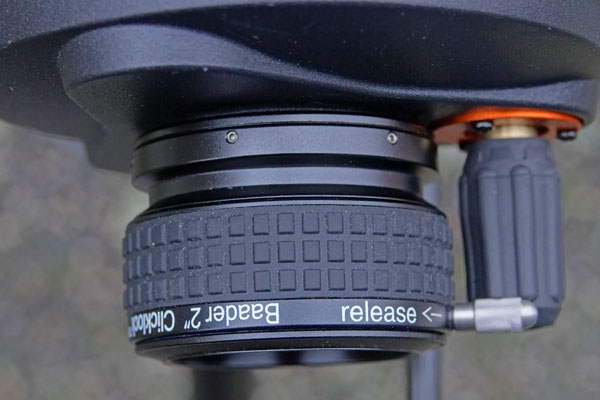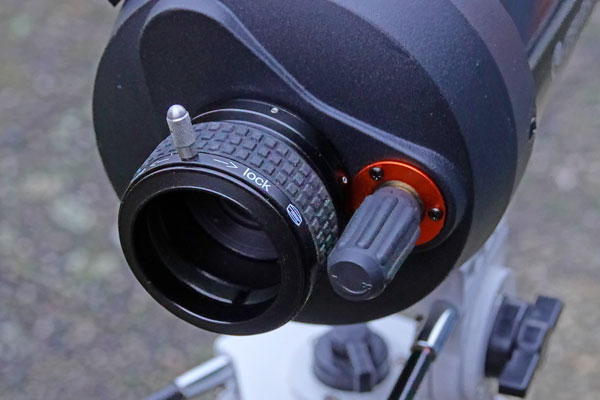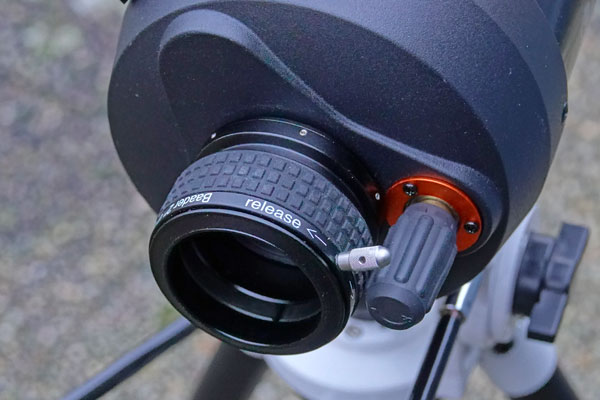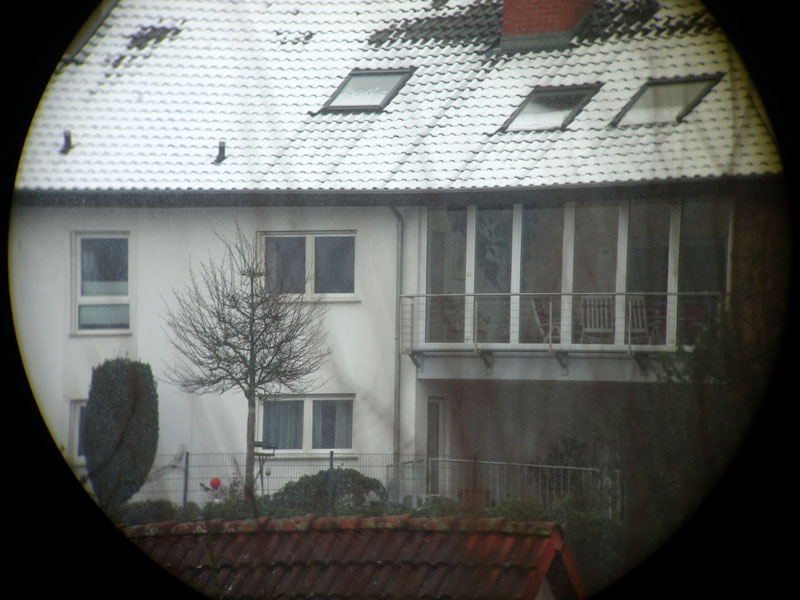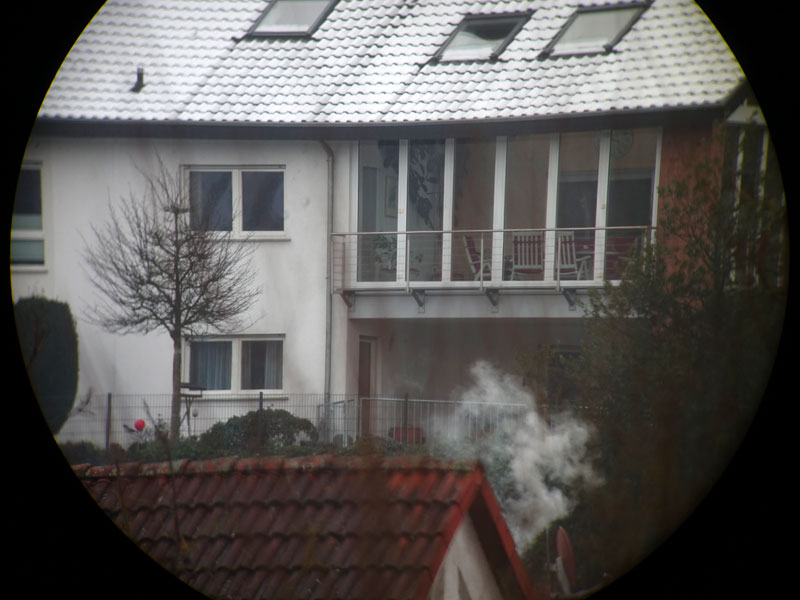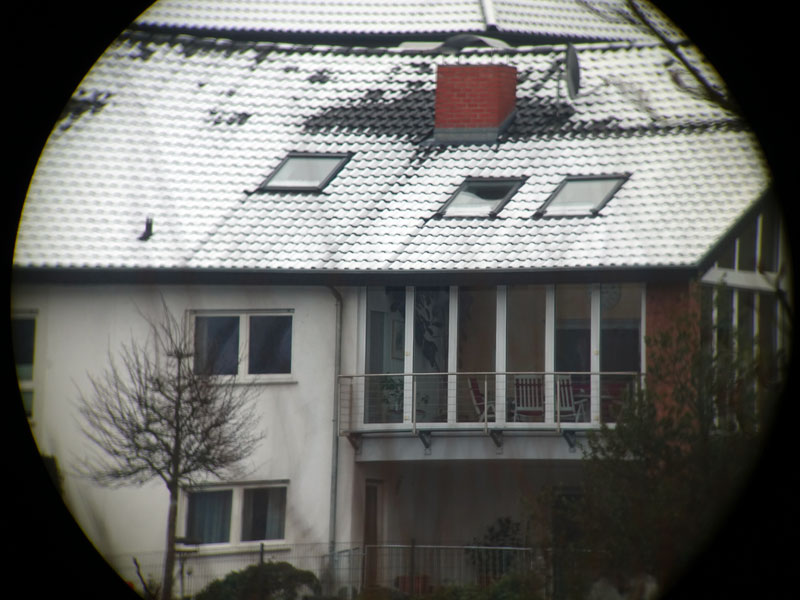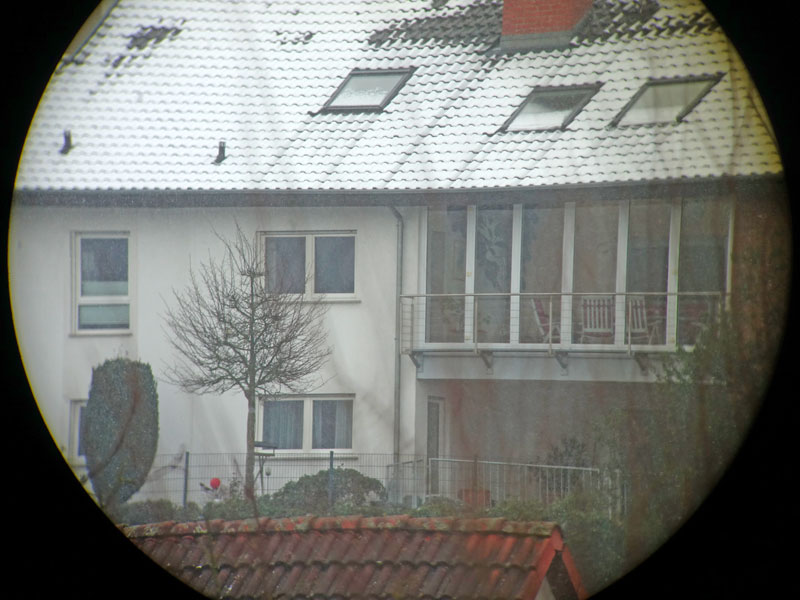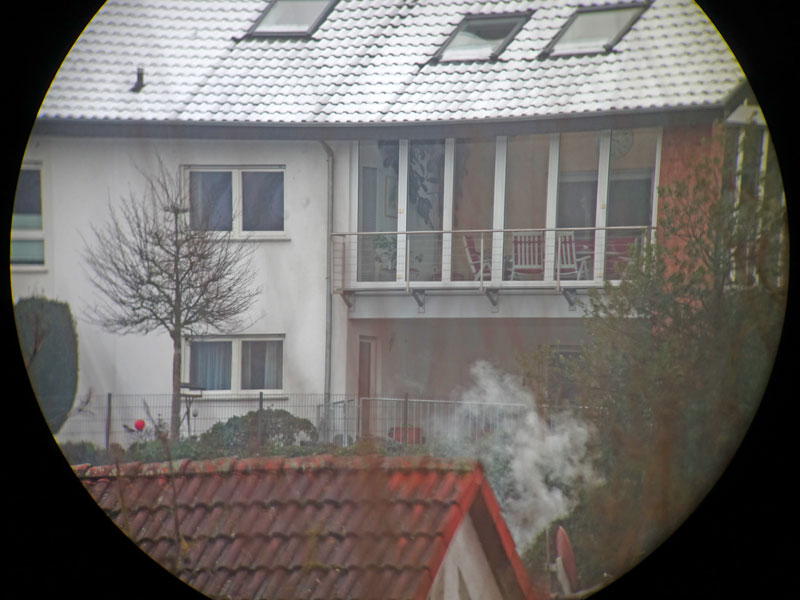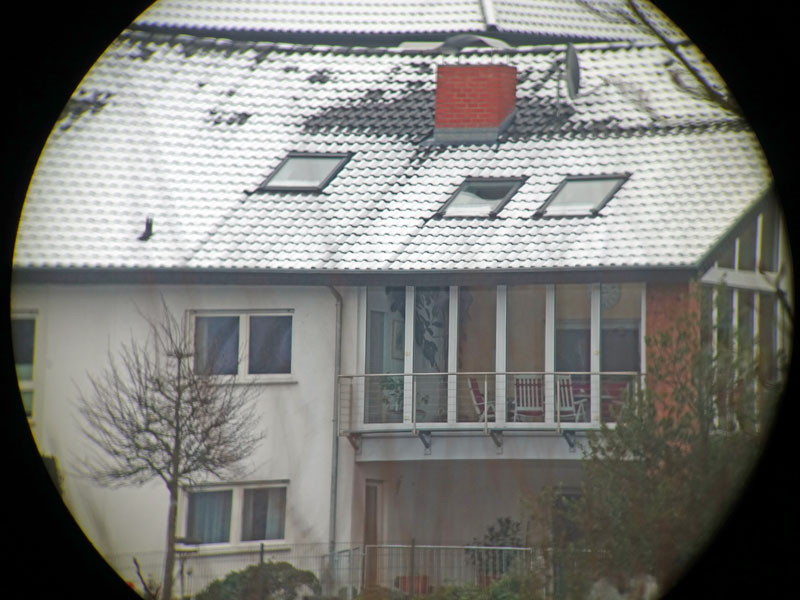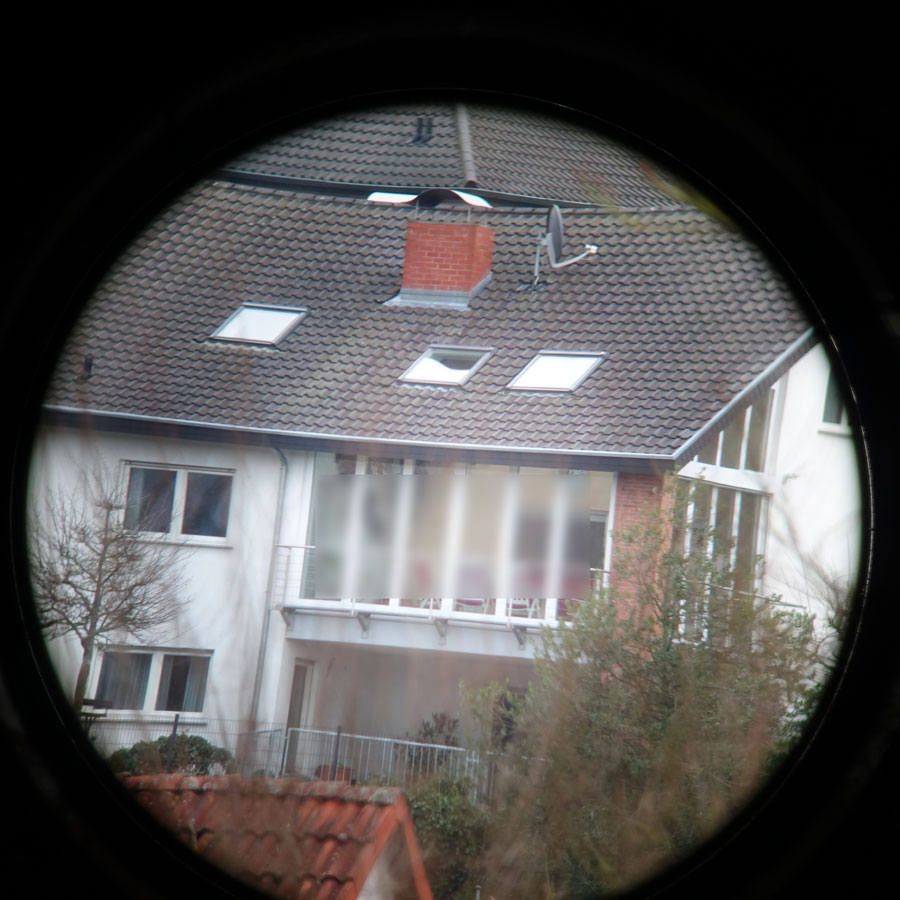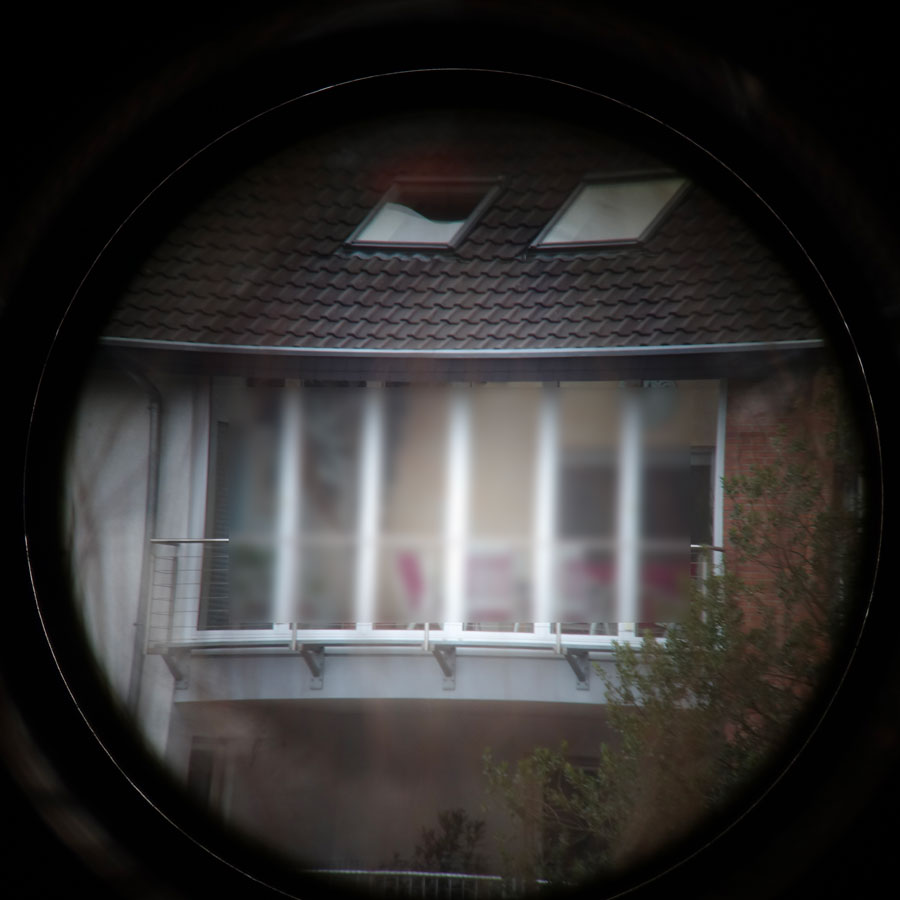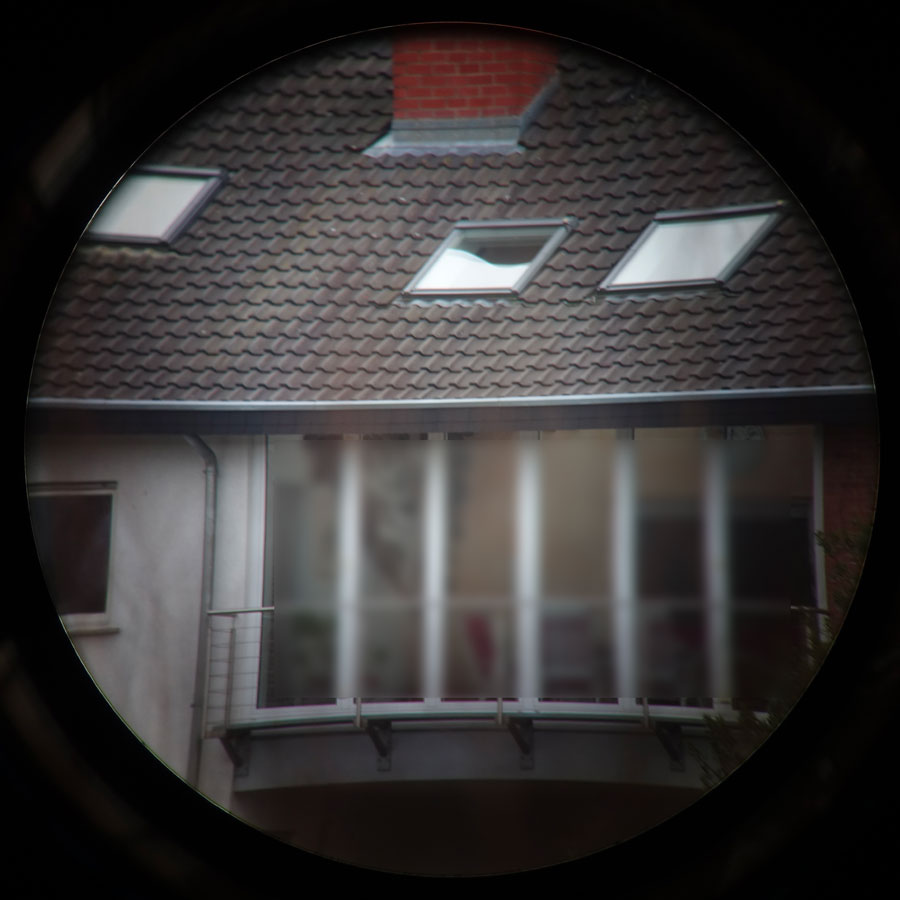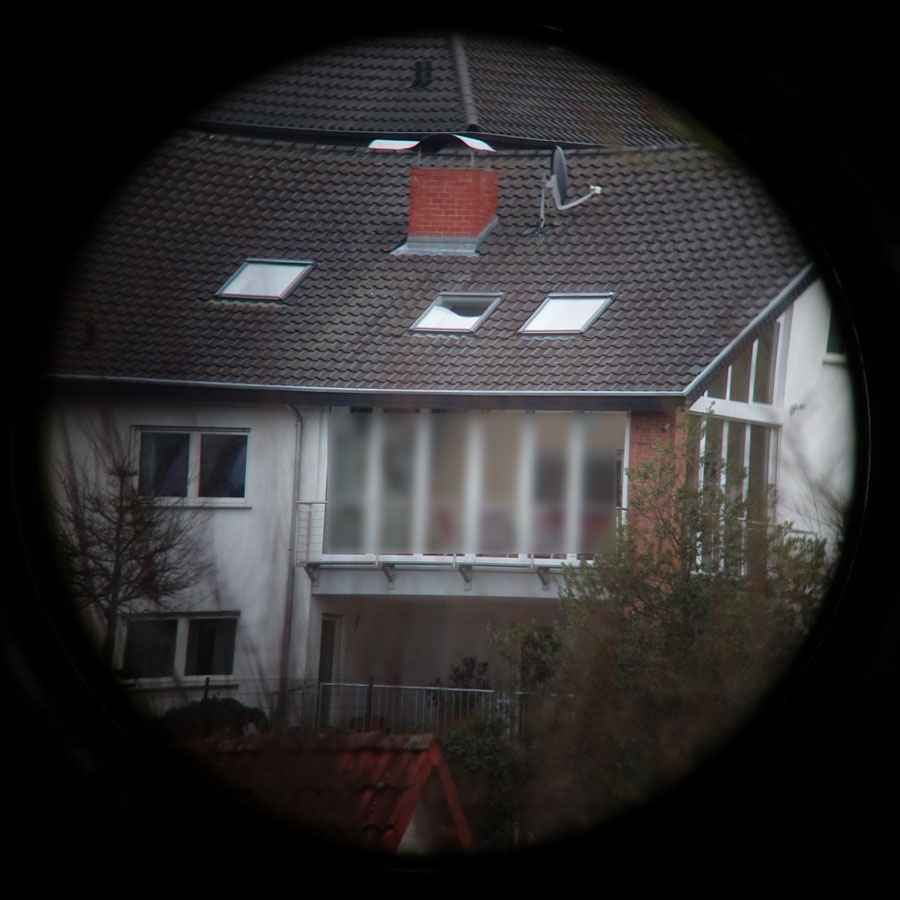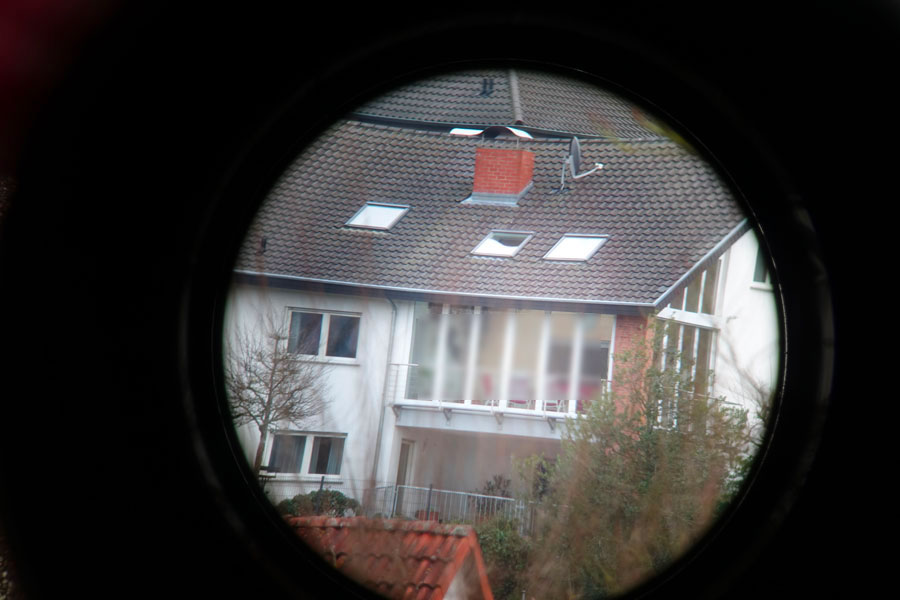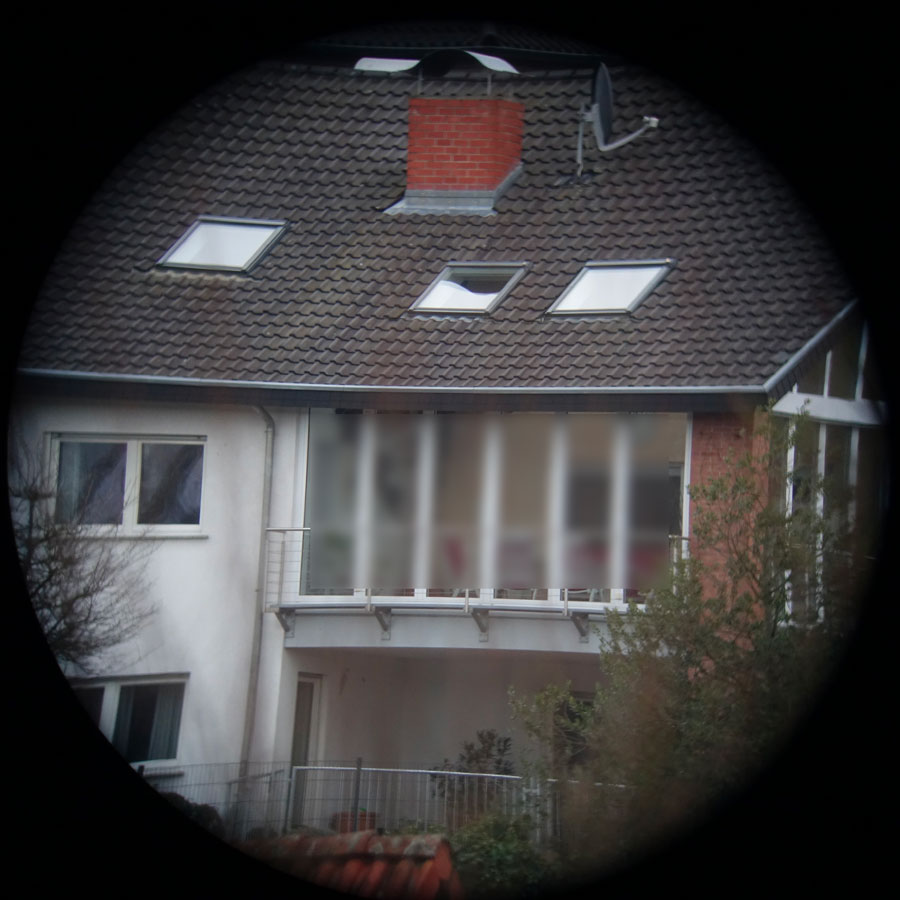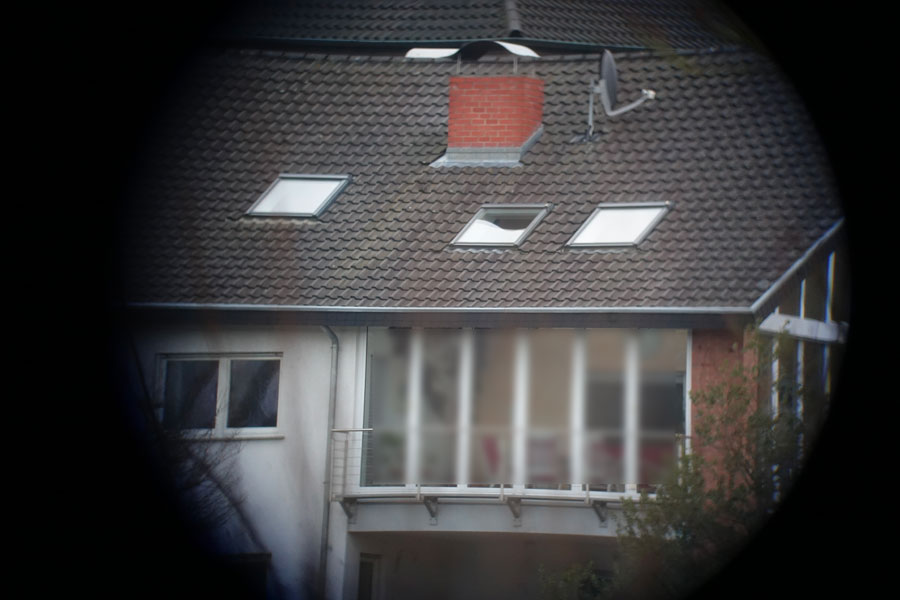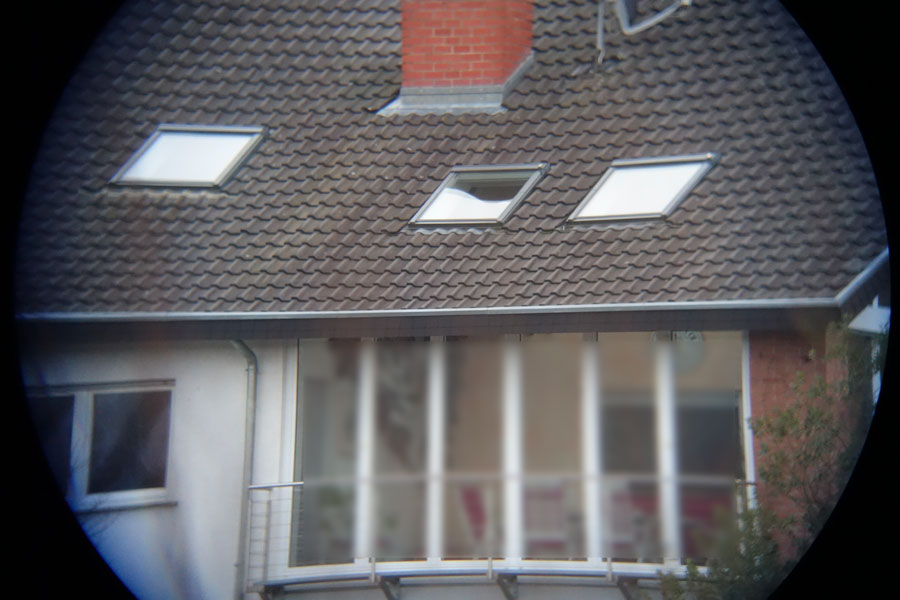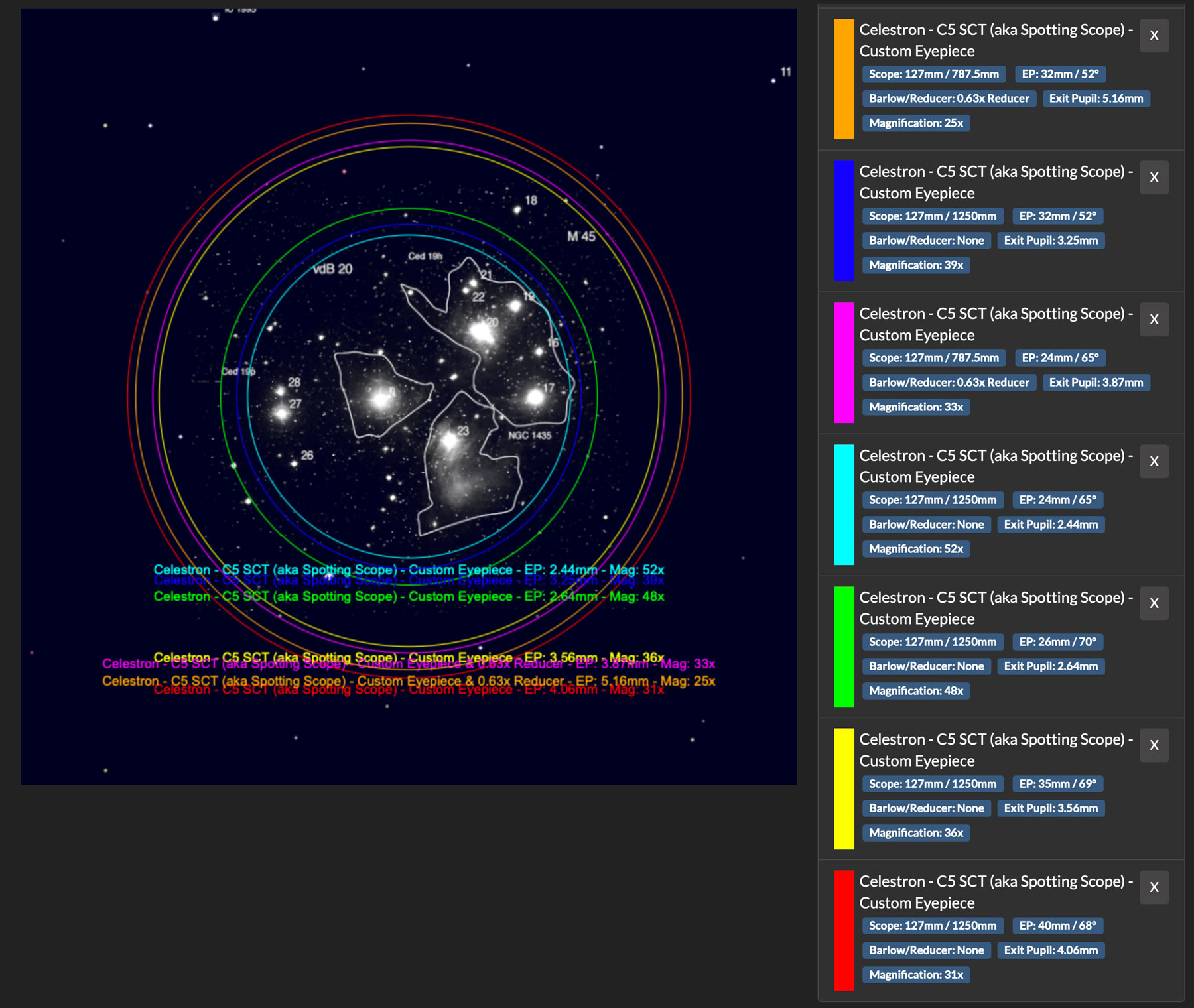C5 - Two Inch Accessories - Yes or No?
Introduction | The "Theoretical State of Affairs"... | Baader ClickLock for 2" Accessories and - and Its Pitfalls | Test: 2" Eyepieces at the C5 (Vignetting) | FOV Comparison 2" Eyepieces Versus 1.25" Eyepieces with f/6.3 Reducer/Corrector | "Rich-Field" with the C5: 2" Accessories, 1.25" Accessories with f/6.3-Reducer/Corrector, or Just 1.25" Accessories? | Conclusions | Links | Appendix: FOVSimulations | Appendix 2: Data
On this page I provide some information about the Celestron Schmidt-Cassegrain C5 OTA, which is, however, only marketed as a spotting scope by Celestron (ordered on December 16, 2020; received on December 18, 2020). This telescope is an attempt to acquire a compact, versatile, and comparatively fast travel telescope, which can also be used as a "quick-and-dirty" telescope" and as a spotting scope.
Introduction
The Celestron C5 is sold as, both a spotting scope and a telescope, with a 1.25" visual back, which suggests that it should be used with 1.25" accessories only. Nevertheless, discussions about whether the C5 can be used with 2" accessories keep popping up on astronomy forums. There are many aspects involved, and at the end of this page I try to collect and contrast the various arguments for and against each solution.
2" Accessories - Field of View and Illumination
One aspect in these discussions is that people want to achieve larger fields of view by using 2" accessories. However, as I demonstrate further down, this is not the case, if you use the Celestron f/6.3 reducer/corrector together with 1.25" accessories. In this case, both approaches achieve more or less the same maximum true field of view (TFOV).
When using 2" accessories, also the question arises, whether the telescope used, here the C5, can illuminate the full field of view at all. This question can on the one hand be tackeled theoretically or practically by simply connecting 2" accessories to the telescope - provided that this is possible at all. With the C5, I had to use some "trickery" in order to be able to connect 2" accessories to it... In the end, I succeeded and thus, I can further down report not only on my theoretical, but also on my practical results regarding 2" accessories.
2" Accessories or Reducer/Corrector and 1.25" Accessories or 1.25" Accessories Only?
Of course, as a new C5 owner, I was on the one hand interested in finding out, whether I would actually be able to use my existing 2" accessories (zenith mirror, eyepieces) on my C5 tube. Somehow one always expects that these would lead to better results...
On the other hand, I had found from my eyepiece data tables that with the f/6.3 reducer/corrector and my 1.25" eyepieces, I can cover a magnification range from 25 x to almost 200 x and an angle of view range from 2° down to 0.5°. This would be a very convenient solution for me, especially on vacation. However, experts as well as star friends advised against using a reducer/corrector. In a Cloudy Nights discussion, on the other hand, I found that some participants preferred the reducer/corrector solution at least for large FOVs, especially because they considered the C5 "overloaded" with 2" accessories (in their opinion, these do not fit well such a small tube). As already mentioned, both solutions are identical with respect to the maximum TFOV (for details see below).
A third approach would be to constrain onself to 1.25" accessories and not use a reducer/corrector. This would result in a minimum magnification of 40 x and a maximum FOV of 1.33°. Or one would use the reducer/corrector only for the eyepieces with long focal lengths.
Theory and Practice
Since discussions and advice are one thing, theoretical considerations another one, and own experiences yet another one, I therefore tried to form my own opinion by on the one hand doing some calculations, and practical tests in daylight on the other hand. First, I describe the results of my calculations. After finding a solution for connecting the Baader 2" ClickLock clamp to the C5, I first checked to what extent my existing 2" eyepieces are usable at the C5, especially whether they would vignette disturbingly. In a second test, I checked whether the results that the calculations for "maximum" 2" eyepieces versus "maximum" 1.25" eyepieces with reducer/corrector yield, namely that approximately the same FOV is achieved, can also be confirmed in practice.
Opinions Vary...
At the bottom of this page, I collect opinions on the various solutions cand contrast them. There is, however, not a definitive answer for me...
The "Theoretical State of Affairs"...
True Field of View
Until now, I had always determined the true field of view (TFOV) of eyepieces by the apparent field of view and the magnification. For this, the apparent field of view of the eyepiece must be known. This is not always the case, and I had then estimated it via the eyepiece type. In addition, the manufacturers' field of view specifications are not always correct, and the accuracy of the magnification also depends on whether the specifications for the telescope focal length and the eyepiece focal length are actually correct.
Alternatively, I have come across (been given) a rule of thumb that determines the field of view based on the field stop of the eyepiece and the telescope focal length:
- 57.3 *Field stop [mm] / Telescope focal length [mm]
The size of the field stop can (rather rarely...) be taken from the technical data of the eyepiece or you have to measure it yourself, if this is possible.
Which Eyepieces Have the Maximum True Field of View?
The maximum true field of view for a telescope port (1.25", 2", 3", ...) is obtained by substituting into the above formula the maximum field aperture for that port. My naive idea that the field of view depends on the eyepiece focal length is valid only up to the point where the size of the field stop comes close to the size of the eyepiece port. Since the receptacle has a certain thickness and the lenses are screwed with rings, the maximum field aperture is always smaller than the port dimension (which is, after all, also the outer dimension).
So I searched the literature and the Internet for the maximum field stops for the respective ports. For 1.25" eyepieces, I found values between 27 and 29 mm (29 mm seems to be the absolute maximum), for 2" eyepieces a value of 46 mm.
But which eyepieces have these maximum field stops? According to various oral and Internet sources, the 1.25" mount is "maxed out" with a 25 mm eyepiece with 70° viewing angle or a 32 mm Plössl eyepiece with 52° viewing angle with respect to the maximum field of view. For the 2" mount, I found that with a 40 mm eyepiece with 70° angle of view, or a 56 mm Plössl eyepiece with 52° angle of view this to be the case. The 70° eyepieces show the objects larger, the 52° eyepieces show a brighter (larger exit pupil), smaller image. Everyone will have their own preferences here. Other focal length/angle combinations would also provide a maximum field of view, the eyepieces mentioned here are common "standard" eyepieces.
Maximum True Field of View at the C5
If I enter the maximum field apertures of 29 mm for 1.25" and 46 mm for 2" into the above rule of thumb for the focal lengths of the C5 without and with a f/6.3 reducer/corrector (1250 mm and 787.5 mm), I get the maximum true fields of view of 1.33° and 2.11°:
- 1250 mm: 1.33° for 29 mm/1.25°; 2.11° for 46 mm/2"
- 787.5 mm: 2.11° for 29 mm/1.25"; 3.35° für 46 mm/2"
One result of these calculations is that the maximum true fields of view at 1.25" with f/6.3 reducer/corrector and at 2" without it are virtually identical (this is also where many debates are about). Why is this the case? From what I know and have read, it is because Celestron designed the f/6.3 reducer/corrector to do just that! If you divide the maximum field apertures for 1.25" and 2" by each other, you get: 29/46 = 0.63, which is the reduction factor of the reducer/corrector (if you divide 1.25 by 2, you get 0.625).
Some Nitpicking...
Often you can also find the value 27 mm for the maximum field aperture at 1.25". This would result in: 27/46 = 0.59. So the 2" solution would be at a slight advantage (2.11° compared to 1.96°). However, 2" accessories are supposed to extend the focal length of the C5 to 1280 or even 1375 mm, which would cancel out the 2" advantage again (1280 mm: 2.06°; 1375 mm: 1.92°). All in all, it looks to me more like the maximum field of view is just under 2° for both solutions.... Nevertheless, for the sake of simplicity, I will work with the "ideal" values for the true field of view given above in the following.
For more details, see also this Cloudy Nights posting from the repeatedly cited discussion! Here it is also noted that the wall thickness of the sleeve gives a small advantage for 2" because it has less influence, relatively speaking. This is probably "nitpicking"!
Field Stop in Action!
Of course, I was tempted to apply the above rule of thumb to my own eyepieces. For this purpose, I roughly measured the field stops of my long focal length eyepieces (for these, it was possible). Then I used the rule of thumb to calculate the true field of view (called TFOV in the following table) of these eyepieces and compared them with the values calculated from the apparent field of view. In addition, I included the two other eyepieces mentioned above with maximum field of view (56 mm/52° at 2" and 25 mm/70° at 1.25") in the table (in blue):
| Focal Length of Eyepiece | Connection | Field Stop | Viewing Angle* | Focal Length of Telescope | R/C | TFOV** from Fied Stop | TFOV** from Viewing Angle* | Magnifi- cation |
Exit Pupil |
| 26 mm | 2" | 33 mm | 70° | 787.5 | yes | 2.40 | 2.31 | 30.3 | 4.1 |
| 35 mm | 2" | 41...42 mm | 69° | 787.5 | yes* | 2.98...3.06 | 3.07 | 22.5 | 5.6 |
| 40 mm | 2" | 45...46 mm | 68° | 787.5 | yes* | 3.27...3.35 | 3.45 | 19.7 | 6.3 |
| 56 mm | 2" | 46 mm | 52° | 787.5 | yes* | 3.35 | 3.70 | 14.0 | 8.9 |
| 26 mm | 2" | 33 mm | 70° | 1250 | 1.51 | 1.46 | 48.1 | 2.6 | |
| 35 mm | 2" | 41...42 mm | 69° | 1250 | 1.88...1.93 | 1.93 | 35.7 | 3.5 | |
| 40 mm | 2" | 45...46 mm | 68° | 1250 | 2.06...2.11 | 2.18 | 31.25 | 4.0 | |
| 56 mm | 2" | 46 mm | 52° | 1250 | 2.11 | 2.33 | 22.3 | 5.6 | |
| 24 mm | 1.25" | 24 mm | 65° | 787.5*** | yes | 1.75 | 1.98 | 32.8 | 3.8 |
| 25 mm | 1.25" | 21...22 mm | 52° | 787.5*** | yes | 1.53...1.60 | 1.65 | 31.5 | 4.0 |
| 25 mm | 1.25" | 29 mm | 70° | 787.5 | yes | 2.11 | 2.22 | 31.5 | 4.0 |
| 32 mm | 1.25" | 27...28 mm | 52° | 787.5*** | yes | 1.96...2.04+ | 2.11 | 24.6 | 5.1 |
| 24 mm | 1.25" | 24 mm | 65° | 1250 | 1.10 | 1.25 | 52.1 | 2.4 | |
| 25 mm | 1.25" | 21...22 mm | 52° | 1250 | 0.96...1.01 | 1.04 | 50 | 2.5 | |
| 25 mm | 1.25" | 29 mm | 70° | 1250 | 1.33 | 1.40 | 50 | 2.5 | |
| 32 mm | 1.25" | 27...28 mm | 52° | 1250 | 1.24...1.28 | 1.33 | 39.1 | 3.2 |
*) apparent field of view; **) true field of view; ***) with f/6.3 reducer/corrector; +) with a field stop of 29 mm, a TFOV of 2.11° is achieved; ++) with a field stop of 29 mm, a TFOV of 1.33° is achieved; blue: eyepieces with maximum true viewing angle, not in my possession; *) vignetts a little in practiccal tests; *) should vignett (I cannot check this).
By the way: Most of the time, the TFOV values calculated from the field aperture are lower than those that I calculated from the apparent angle of view; the latter usually result in the maximum values. So the manufacturers "cheat" on the apparent angle of view (almost) all a bit...
The table shows for "real eyepieces" what I have shown shown for "maximum cases", namely that for the maximum field stops at 1.25" with recuder/corrector and 2" without it one arrives at approximately the same angle of view. Even the magnification is virtually identical for eyepieces with similar apparent fields of view! The exit pupils, or image brightnesses, are also very similar. For confirmation, compare, for example, the 40 mm/60°n eyepiece and the 25 mm/70° eyepiece with reducer/corrector!
This makes me wonder what the advantage of the 2" eyepieces is in the first place. Perhaps this will be clarified when I compile the arguments for the individual solutions at the end...
Illumination of 2" Eyepieces
Decisive for the usability of eyepieces is how far the image circle of the eyepieces can be illuminated by the telescope. For 1.25" eyepieces, the maximum field stop (or its diameter) 27 to 28 mm, for 2" eyepieces an image circle of 46 mm is stated. But what about telescopes and the C5 in particular?
For the C5, I found the statement that "the rear axial port on a C5 is approximately 25 mm in diameter" in a Cloudy Nights discussion. This is even a bit less than the maximum possible 27 or 28 mm for 1.25" eyepieces. I then searched further and found in the Cloudy Nights thread Rear Opening Sizes of Celestron SCT OTAs the following values for Celestron tubes:
- C5: 25 mm
- C6: 27 mm (elsewhere*, I found the values 26 mm, 25 mm, and "like the C5")
- C8: 38 mm
- C9.25: 45 mm or 48mm
- C11: 54 mm
- C14: 54 mm
*) How to calculate Maximum Field of View in c6 SCT (please scroll through the thread)
I therefore looked into the back of the C5 myself (January 20, 2021) and tried to measure the diameter of the port (a long thin tube called rear baffle...) - and can confirm a diameter of 25 mm
With a diameter of 25 mm at the telescope end, my 2" eyepieces should not be well illuminated, and even my 32 mm Plössl eyepiece with 1.25" mount should vignette slightly. High time for a practical test to clarify whether theory and practice match!
Baader ClickLock for 2" Accessories and - and Its Pitfalls
In astronomy forums I came across discussions in which the question was raised, whether 2" accessories can be meaningfully used on the C5. In the end, I have not been able to find a clear answer, actually it is "no". Despite this answer, some posters have decided to buy 2" accessories. So I thought I would give it a try myself, since I have 2" accessories available from the C8 (and from the refractors). However, I failed after only a few turns: the Baader ClickLock adapter cannot be screwed onto the SC thread on the tube, because the locking lever of the adapter bumps against the focusing knob of the C5.
I made a second attempt on this, after I had removed the locking lever. Read more on this on page C5 - Issues and Modifications. After this attempt, I decided to purchase another ClickLock adapter for the C5. In the meantime, it arrived, and I installed it:
|
ClickLock open (locking lever screwed on again) |
ClickLock "locked" |
40 mm eyepiece (2") |
So this openen up the possibility to test 2" accessories at my C5!
Test: 2" Eyepieces at the C5 (Vignetting)
The goal of my first test with 2" eyepieces on the C5 was to find out whether my 2" eyepieces could be used at the C5 without major limitations, especially I was concerned about vignetting. This test took place on January 18, 2021, was my second test at daylight, and was performed with two 1.25" eyepieces (24 mm, 32 mm) and three 2" eyepieces, that is, with all of my eyepieces with longer focal lengths.
With the 2" eyepieces, which all have an apparent field of view of about 70°, I found that the field of view increased with increasing focal length. I also found no evidence that the images were cropped, but cannot rule that out. Since I had largely forgotten the results of the first test, I decided to photograph the views this time. This did not succeed with all eyepieces, but it was successful to the extent that, this way, I can prove my statement that the C5 is suitable for 2" accessories. These photos are not suitable to judge the vignetting, because the camera, a Sony RX100 M4, also contributes to the vignetting.
 |
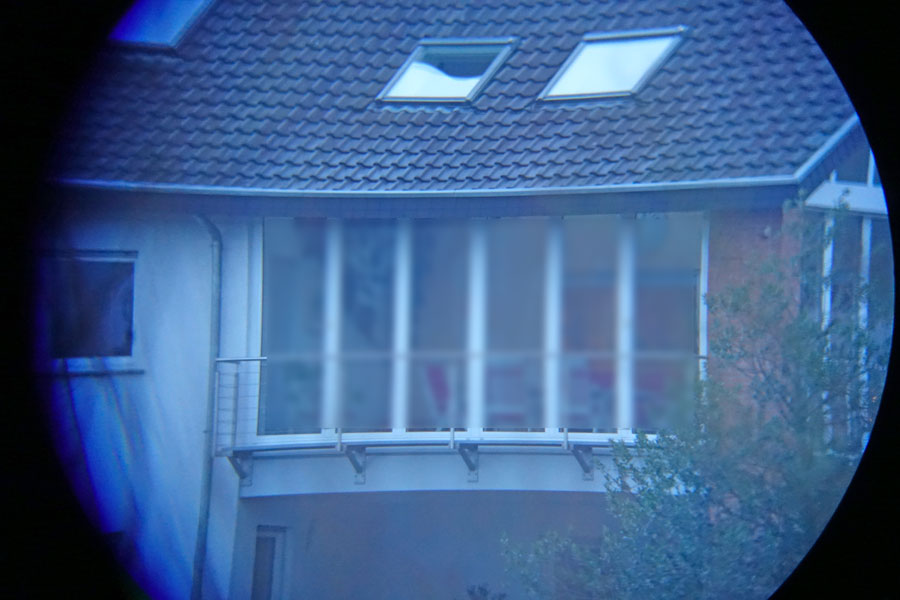 |
|
32 mm Digiscope eyepiece (Plössl, 1,25" => 1.33°) |
26 mm eyepiece (2", 70° => 1.46°) |
|
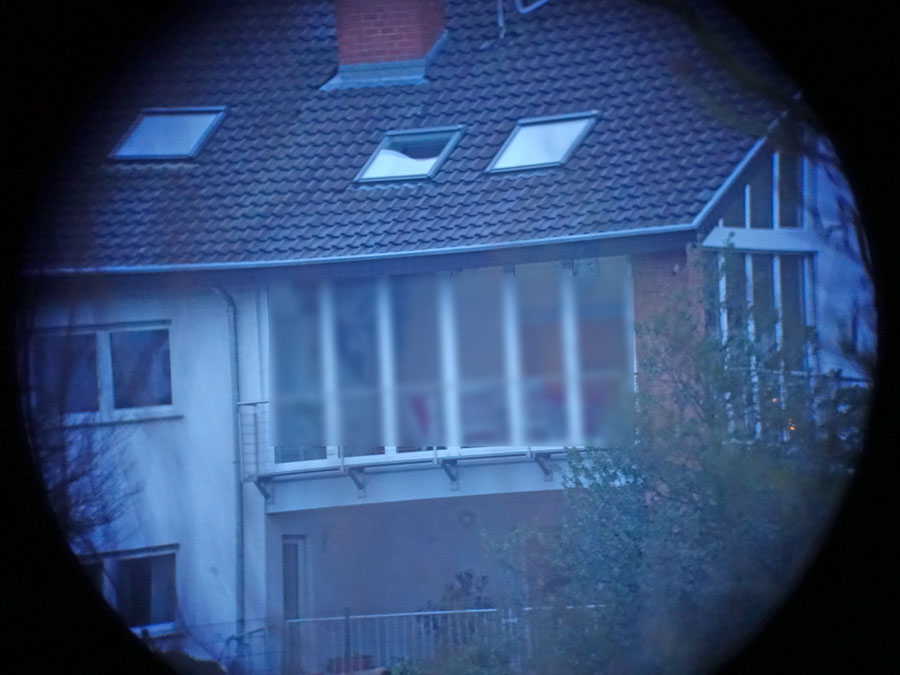 |
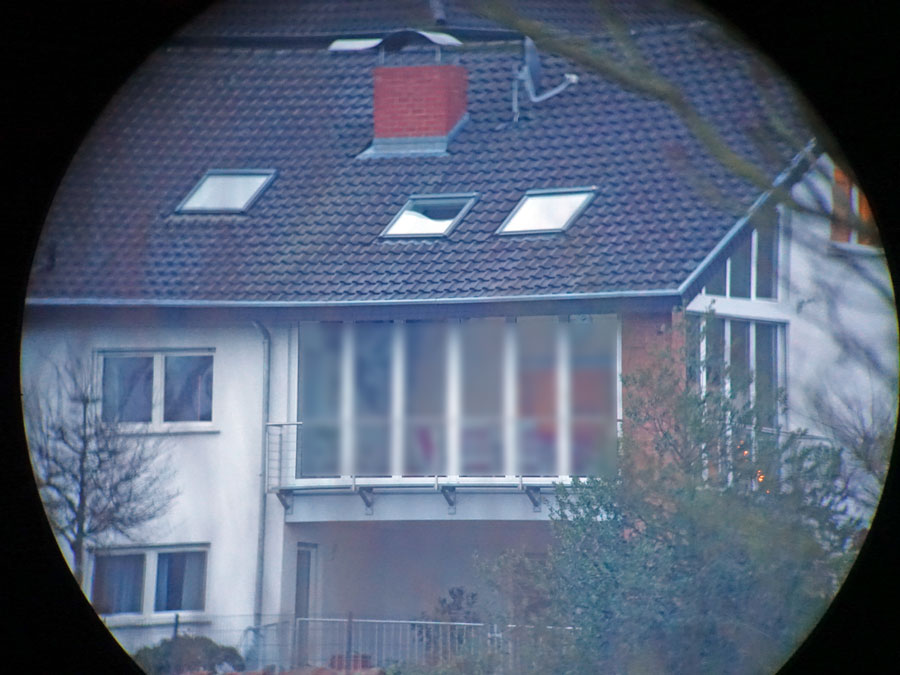 |
|
35 mm eyepiece (2", 69 ° => 1.93° ) |
40 mm eyepiece (2", 68° => 2.18°) |
I calculated the true angles of view given below the photos from the apparant ones and the magnifications (as I normally do). Now one would have to calculate back on the basis of the photos by the rule of three, whether the angles correspond approximately to the practice! I did this roughly and, if I assume a viewing angle of 50° instead of 52° for the 32 mm eyepiece, I come close to the calculated viewing angles, at least, for the 35 and 40 mm eyepieces (for the 26 mm eyepiece, the viewing angle is somewhat larger than calculated)!
On January 23, 2021, I did another small "after test" during the day with my 2" eyepieces and the f/6.3 reducer/corrector, although this is certainly a somewhat unusual combination. The reducer/corrector was screwed directly to the tube, followed by the ClickLock adapter and then the 2" zenith mirror including the eyepiece. I can only show partial results here in the form of photos, because the camera vignetted too much. It reads: no visible vignetting with the 26 mm eyepiece, slight asymmetrical vignetting with the 35 mm, and slightly stronger asymmetrical vignetting with the 40 mm eyepiece, with both eyepieces showing the same image (because the vignetting works identically). This way, I achieve a TVOF of up to 3,4° (estimated by comparing two photos). However, due to the vignetting it will not be more than 3° in practice...
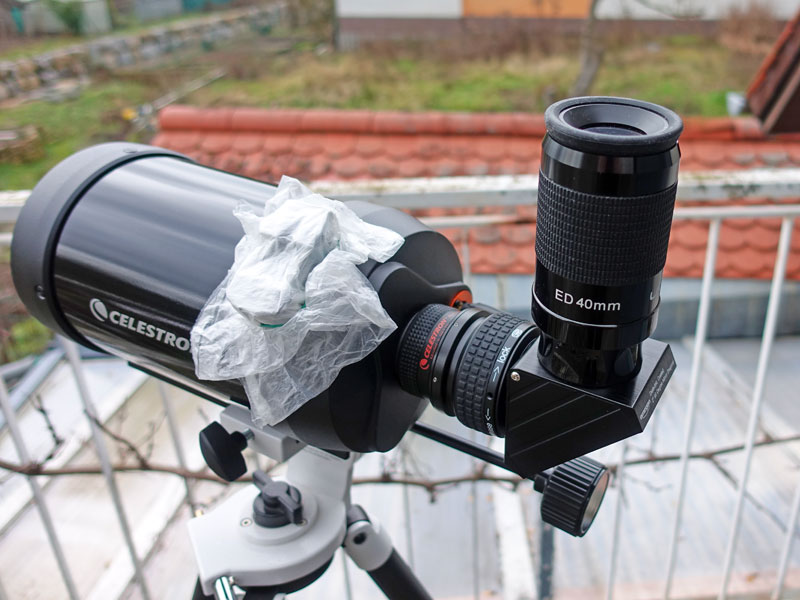 |
 |
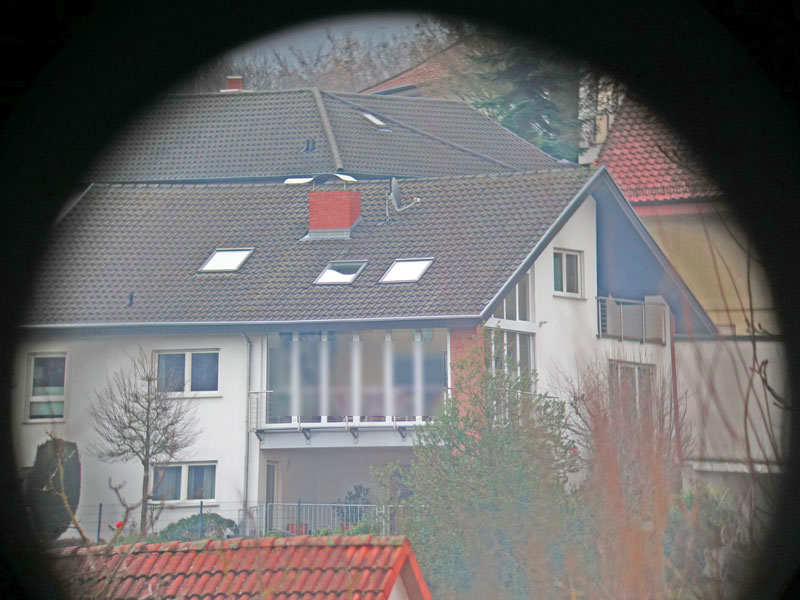 |
||
40 mm eyepiece (2", 68°) with Reducer/Corrector |
Image somewhat made brighter |
Image made very bright to show the field of view => about 3.4° (via image comparison) |
I repeated this test with the C8 (January 23, 2021) and arrived at very similar results. I conclude that the vignetting results from the interaction of the reducer/corrector and the 2" zenith mirror and has nothing to do with the diameter of the rear baffle (two different 2" zenith mirrors lead to about the same results). Nevertheless, this way you get the largest field of view, but the 35 mm eyepiece is sufficient (the 40 mm eyepiece provides the same field of view, only smaller).
On January 27, 2021 I did another test at the C5 with a 2" SC zenith mirror. For this purpose, I "rebuilt" the 2" zenith mirror from TS-Optics that I had originally purchased as an SC zenith mirror for the C8, but then converted to a 2" zenith mirror; rebuilding was very easy. The first thing I did was to try it out with the f/6.3 reducer/corrector, because I wanted to see whether there were any differences from the other zenith mirrors, since the light path is a bit shorter with the SC mount. And indeed, the vignetting seemed to be a bit more pronounced here to me with the 35 mm and 40 mm eyepieces. So this is not an option! Since the reducer/corrector moves the zenith mirror further back, there was also no collision between the zenith mirror and the C5's focuser.
Afterwards, I tested the SC zenith mirror with 2" eyepieces also without the reducer/corrector on the C5. Surprisingly, there was no collision between the focuser of the C5 and the SC zenith mirror, while there had been one with the C8. The results with the three 2" eyepieces were similar to those with the other zenith mirrors - perhaps the vignetting was slightly stronger than with these (see the photos below). In any case, much better than with reducer/corrector!
Distortions
A star friend drew my attention to the pincushion distortions in the photos and wrote that possibly the camera might be responsible for part of the distortions. I examined this the next day (January 19, 2021) more closely. However, I was not able to find a recognizable influence of the camera on the distortions, these are therefore produced by the telescope. Thereupon I not only examined the C5 for distortions, but all the others as well out of curiosity. Practically all my telescopes showed distortions, although with differences (I tested this on the gutter, which I moved from the bottom to the top of the field of view, and which bent thereby). Most interesting for me was the comparison with the Skymax-127, which can only be operated with 1.25" eyepieces. Here is the result with my 32 Plössl eyepiece (the only one that I was able to take photos with):
 |
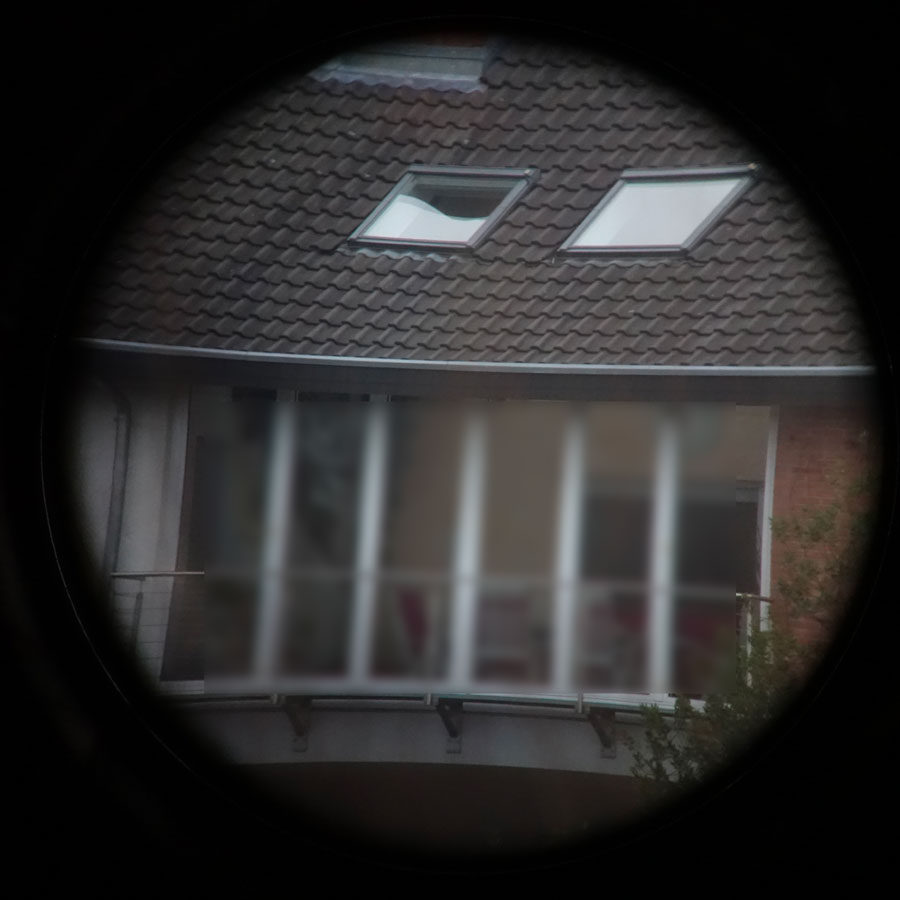 |
|
C5 with 32 mm Digiscope eyepiece (Plössl, 1,25" > 1.33°) |
Skymax-127 with 32 mm Digiscope eyepiece (Plössl, 1,25" > 1,11°) |
All in all, the pincushion distortions of both telescopes are comparable.
Conclusions on the First Practical Test
So, after this test, I can join the initiator of the discussion in Cloudy Nights and ask: Why are my 2" eyepieces satisfactorily illuminated by eye (and even with a camera) despite the too small openig at the end of the rear baffle? A (to me) satisfying answer to this is not given in the mentioned discussion - and I cannot give one either. So below I collect opinions on the subject of "2" accessories, 1.25" accessories with reducer/corrector, or just 1.25" accessories without changing the focal length of the telescope?"
Here is at least one attempt by one of the discussion participants:
My guess (I'm not an expert) is that the answer is two-fold:
- The rear baffle is far enough away from the focal plane that it isn't in focus and therefore is not a hard fieldstop -- therefore it only produces fall-off and not a hard vignette.
- Human eyes and brains are remarkably good at compensating for this sort of fall-off.
Here is another explanation from the same discussion:
- A field stop well removed from an otherwise limiting baffle has that obstructor well out of focus, with the result that its shadow is made quite diffuse. Furthermore, any of the system's off-axis chief rays, which pass through the center of the entrance pupil, necessarily diverge outward and away from the optical axis as they proceed to the focal surface. This results in a larger circle of illumination for any selected illumination level, which in turn permits to use a larger field stop.
- Of course, moving-primary telescopes introduce their own wrinkles which result in varying field illumination (and at some point, aperture reduction even on axis) as the focal surface is made to move in/out. But to first order, throwing the focus farther back does permit to utilize eyepieces with surprisingly 'oversized' field stops relative to the rear port aperture.
FOV Comparison 2" Eyepieces Versus 1.25" Eyepieces with f/6.3 Reducer/Corrector
So the first test was about the question whether 2" eyepieces cause disturbing vignetting. This could be negated. On January 19, 2021, I took photos primarily to see how photos with long 2" focal lengths compare to those with longest possible 1.25" focal lengths when using the Celestron f/6.3 reducer/corrector. Previous calculations of the field of view showed that the field of view of the 2" eyepiece with 40 mm focal length hardly differs from that of the 1.25" Plössl eyepiece with 32 mm. Here are some image examples:
Conclusions on the Second Practical Test
In the end, I got the result that I had calculated before, namely that both solutions deliver equivalent fields of view. However, the image in the 40 mm eyepiece (2") appears thand to the larger viewing angle (68° versus 52°) considerably larger than that of the Plössl eyepiece. But a 25 mm/70° eyepiece with a 1.25" mount would provide a very similar image impression compared with the 40 mm eyepiece.
Of course, one can ask what is the benefit of a test that yields what one already knew beforehand. For me, the benefit of the test is to show that both solutions work and are usable. Which one you then choose, will depend on the particular circumstances or personal preferences.
Rich-Field with the C5: 2" Accessories, 1.25" Accessories with f/6.3-Reducer/Corrector, or Just 1.25" Accessories?
The photos of the first practical test show for me that the C5 is definitely 2"-capable, the second test answers the question whether with 1.25" eyepieces and an f/6.3 reducer/corrector the same maximum field angles can be achieved as with 2" accessories. It once again confirms in practice what is shown in a forum discussion on Cloudy Nights using numerical examples - and what my own eyepiece tables and research on field aperture also show. However, the field stop data also suggests that 2" eyepieces are not sufficiently illuminated in the C5 - contrary to my field tests and the fact that quite a few C5 owners use 2" accessories without complaint. Other C5 owners, however, prefer the combination of 1.25" accessories and the f/6.3 reducer/corrector, while still other astronomers and experts, but mostly not C5 owners, advise against the use of the reducer/corrector (in whole or in part).
In the end, there are well-founded opinions on each side, there is no "right" or "wrong", and everyone has to form his or her own opinion based on the arguments for and against the individual solutions. In the following, I would like to collect and discuss the advantages and disadvantages of these solutions for the Celestron C5.
Beforehand, however, one question can be answered, namely, which maximum TFOV do I get with the different solutions?
- 1.25" accessories: 1.25°...1.33° (depending on the field stop of the eyepiece (27...29 mm))
- 1.25" accessories with f/6.3 reducer/corrector: 2.0°...2.1° (depending on the field stop of the eyepiece (27...29 mm))
- 2" accessories: 2.0°...2.1° (depending on the field stop of the eyepiece (45...46 mm))
- 2" accessories with f/6.3 reducer/corrector: 3.0°...3.4° (depending on the vignetting)
The second and third solution allow you to overlook the Pleiades M 45 completely. This might almost be called "rich-field" astronomy. I will probably not use the fourth solution...
Collecting Arguments...
The author of the initial posting on 2" accessories on the C5 in Cloudy Nights and others prefer the combination of 1.25" eyepieces and reducer/corrector. On the other hand, a Baader employee and star friends have just advised me against using the reducer/corrector. In my daytime tests, I liked the 2" solution better, a test at night is still pending. A third approach would be, as already written above, to work with 1.25" accessories without a reducer/corrector - possibly only when using short eyepiece focal lengths. In the following I attempt to summarize what I have read on Cloudy Nights and what advice I have been given on this subject.
Pro 1,25" Accessories with Reducer
Most of the C5 owners state that they use the 1.25" accessory solution in combination with the reducer/corrector. They also provide specific recommendations on eyepieces, which I will not go into here.
- Using the F/6.3 reducer/corrector allows you to get the same fields with 1.25" eyepieces, but with better ergonomics.
- 2" is too much weight and bulk for a telescope that is best for maxing out aperture in a small, compact package. Can you imagine a 2" diagonal + 41 Pan sticking out the rear of a poor little C5?
- Big 2" eyepieces plus a 2" diagonal can weigh as much as the OTA, causing balance issues
- The focuser knob and my XLT 2" SCT diagonal do not get along particularly well.
Some also use the 2" solution, or at least have tried it, but prefer the "small" solution:
- I've put my 38mm Q70 on a C5, just to see how it worked. It worked better than I expected, but it sure looks silly.
Nobody here criticizes that the reducer/corrector would bring too much glass into the light path. I only read this criticism from experts/star friends who do not own or use a C5:
- Reducer only for wide field and the rest with eyepieces without reducer, otherwise you will ruin the good optics again...
- For the reducer to work well photographically, it should be mounted on the 2" SC thread in the same way as the visual back. Visually it brings too much glass in the way so that instead of the reducer a long focal length eyepiece should be used. So you have to decide and I personally would vote against the reducer.
It is also discussed, which solution provides a larger field of view, but in the end this turns out like Hornberg shootout: in practice, it comes down to the same result. Here is an example (for the C6, but the same applies there):
- Of course, from my perspective, knowing what I know now, I'd see no reason to use the 2" route, with all the extra weight hanging off the back, when I can get there with equal performance, and same field.
Pro 2" Accessories
Manche C5-Besitzer finden das Bild mit 2"-Zubehör äthetischer; ein Experte spricht von Vorteilen, ohne sie zu nennen, spricht aber allgemein das Problem der Vignettierung bei 2"-Zubehör an (ohne mangels Erfahrung damit konkret zu werden...):
- I did enjoy the views with the 2 inch eyepieces, in particular the 32
mm TV Wide Field.
There is more to the view than just the magnification, the AFoV, the sharpness, there's the combination of aesthetic factors one might call "presentation.". This is where eyepiece's like 32 mm WF can be preferred over a shorter focal length eyepiece used with a reducer/corrector.. - 2" accessories can have certain advantages. The illumination of the
eyepieces is another matter. Above 30 mm eyepiece focal length, the illumination
is no longer fully given, on the other hand, the human eye can only poorly
detect vignetting up to 30%. These are all more or less creeping/soft transitions
that cannot be answered with a definite yes or no.
If 2" accessories are already available, there is of course a lot in favor of using a corresponding ClickLock clamp.
Summary...
It seems to be the best to try everything out for oneself and then decide what to use - or try this and that over time... But perhaps I should restrain myself in forums to give advice or opinions. It is hard to recommend something to others on such a "shakey fundament"...
Conclusions
The photos of the first practical test show me that the C5 is definitely 2"-capable. Of course, this test does not answer the question of how useful it is to use 2" accessories on the C5. I have found very different opinions on this, which I compile and discuss at the end of this page. The first test also does not answer the question whether 1.25" eyepieces and an f/6.3 reducer/corrector can achieve the same image angles as 2" accessories. From a purely mathematical point of view, this is the case, and my second practical test also confirms this. Most people would probably have rather expected the 2" accessory to vignette disturbingly.
By the way, a test at night is still pending...
My Conclusions...
If you look at the individual solutions from the point of view of flexibility, I would prefer the 1.25" solution with the reducer/corrector, because with this I can use all of my 1.25" eyepieces and still get a field of view of up to about 2°.
Links
- Celestron USA - C5 Spotting Scope: www.celestron.com/products/c5-spotting-scope
- Celestron Germany (Baader) - C5-Spektiv: www.celestron.de/ce_de/sportoptiken/spektive/c5-spektiv.html (in German)
- Sky-Watcher AZ Pronto Mount Information
- C5 field of view w/ 2" diagonal - some data, maybe . . . (CloudyNights, thread started by Paul Schroeder): www.cloudynights.com/topic/587043-c5-field-of-view-w-2-diagonal-some-data-maybe/
- Rear Opening Sizes of Celestron SCT OTAs (Cloudy Nights, thread started by kenn): www.cloudynights.com/topic/155862-rear-opening-sizes-of-celestron-sct-otas/
- How to calculate Maximum Field of View in c6 SCT (Cloudy Nights, thread started by von chipotle mg): www.cloudynights.com/topic/503168-how-to-calculate-maximum-field-of-view-in-c6-sct/
- Brauche Hilfe bei der Erweiterung der Einsatzmöglichkeiten (Astronomie.de, thread started by BarFly): forum.astronomie.de/threads/brauche-hilfe-bei-der-erweiterung-der-einsatzmoeglichkeiten.300753/
- See also my page offering Astronomy Links.
Appendix: FOV Simulations
For the C5 , I used the astronomy.tools Field of View tool to demonstrate how certain longer focal length eyepices compare regarding the field of view using M 45 (Pleiades).
Here you can see quite well that with 1.25" eyepieces (red) and f/6.3 reducer/corrector a similar maximum field of view can be achieved as with 2" eyepieces (orange). The 26 mm eyepiece with 2" is then again in the range of the long focal length 1.25" eyepieces without reducer/corrector.
In the end, this confirms what I read, namely that you actually only need one eyepiece in the long focal length range, at least as far as the FOV is concerned.
Note: The simulations above are based on the fact that the technical data given for the eyepieces are approximately correct. But according to what I read in discussion forums, you cannot rely on that at all...
Appendix 2: Data for Celestron C5 with f/6.3 Reducer/Corrector
Technical Data
| Telescope: Celestron | C5 |
| Optical Design | Schmidt-Cassegrain |
| Primary Mirror Diameter | 125 mm (5") |
| Focal Length, Focal Ratio | 1250 mm, f/10 |
| Resolving Power (arc secs) | 0.93" |
| Limiting Visual Stellar Magnitude | 13 mag |
| Light Gathering Power | 319 |
| Maximum Practical Visual Power | 250 x: partly, 295/300 x is listed |
| Optical Tube Dimensions (diam. x length) | 15 cm* x 28/33 cm |
| Net Weight Basis | --- |
| Net Weight Optical Tube | 2.72 kg |
| Net Weight Complete | --- |
*) own measurement/calculation; **) corrected values
See also the table of data for all of my telescopes (and a few more...)
Observation-Relevant Data (in Comparison with my 6" Newton Tube)
| Telescope | Focal |
Aperture (mm) |
Focal Ratio |
Light Gathering Power |
Maximum+ |
Minimum* |
Maximum* |
Minimum+ |
|||||
Usable Magnification |
Usable Focal
Length of Eyepiece (mm) |
||||||||||||
Factor/Exit Pupil (mm) > |
Manuf. |
1.5 |
2 |
6.5 |
7 |
6.5 |
7 |
1.5 |
2 |
||||
| Celestron C5 (Schmidt-Cassegrain) | 1250 |
125 |
10 |
319 |
295/300 |
188 |
250 |
19.23 | 17.86 | 65.0 |
70.0 |
6.7 |
5.0 |
| Cel. C5 (Schmidt-Cassegrain) (Red.) | 787.5 |
125 |
6.3 |
319 |
295/300 |
188 |
250 |
19.23 | 17.86 | 41.0 |
44.1 |
4.2 |
3.2 |
| Celestron C8 (Schmidt-Cassegrain) | 2032 |
203 |
10 |
841 |
305 |
406 |
31.26 |
29.03 |
65.0 |
70.0 |
6.7 |
5.0 |
|
| Cel. C8 (Schmidt-Cassegrain) (Red.) | 1280 |
203 |
6.3 |
841 |
305 |
406 |
31.26 |
29.03 |
41.0 |
44.1 |
4.2 |
3.2 |
|
| Skymax-102 (Maksutov-Cassegrain) | 1300 |
102 |
12.75 |
212 |
153 |
204 |
15.69 |
14.57 |
82.9 |
89.3 |
8.5 |
6.4 |
|
| Skymax-127 (Maksutov-Cassegrain) | 1500 |
127 |
11.81 |
329 |
191 |
254 |
19.54 |
18.14 |
76.8 |
82.7 |
7.9 |
5.9 |
|
| Explorer PDS150/Dobson 6" | 750 |
150
|
5 |
459 |
225 |
300 |
23.08 |
21.43 |
32.5 |
35.0 |
3.3 |
2.5 |
|
*) Calculated for an exit pupil of 6.5 mm and 7 mm
+) Factor 1.5 or 2 for Dobsonian/Newtonian telescopes; in general, the lower
value of 1.5 is used for Newtonian telescopes; if the manufacturer specified
a different magnification, it is also listed (some manufacturer provide considerably
higher numbers...).
Visual Power (Magnification) and Other Data for Different Focal Lengths of Eyepieces (Mostly My Current Eyepieces)
Note: These tables include the StarTravel 120 refractor, a TSWA32 eyepiece (2", 32 mm focal length, 70° viewing angle) that I borrowed together with the StarTravel 120, a 18 mm eyepiece (2", 82° viewing angle), a 38 mm eyepiece (2", 70° viewing angle), and a 56 mm eyepiece (2", 52° viewing angle).
I did not include the Celestron 25 mm Plössl eyepiece, which is delivered with the C8, because I gave it away...
| Telescope | Further Data |
Focal Length of Eyepiece (mm) |
||||||||||||
| Magnification | ||||||||||||||
Focal Length of Telescope (mm) |
4 |
7 |
10 |
16 |
18 |
24 |
26 |
32 |
32 |
35 |
38 |
40 |
56 |
|
| PS 72/432 | 432 |
108.00 |
61.71 |
43.20 |
27.00 |
24.00 |
18.00 |
16.62 |
13.50 |
13.50 |
12.34 |
11.37 |
10.80 |
7.71 |
| ST120 | 600 |
150.00 |
85.71 |
60.00 |
37.50 |
33.33 |
25.00 |
23.08 |
18.75 |
18.75 |
17.14 |
15.79 |
15.00 |
10.71 |
| TLAPO1027 | 714 |
178.50 |
102.00 |
71.40 |
44.63 |
39.67 |
29.75 |
27.46 |
22.31 |
22.31 |
20.40 |
18.79 |
17.85 |
12.75 |
| 150PDS | 750 |
187.50 |
107.14 |
75.00 |
46.88 |
41.67 |
31.25 |
28.85 |
23.44 |
23.44 |
21.43 |
19.74 |
18.75 |
13.39 |
| SM127 | 1500 |
375.00 |
214.29 |
150.00 |
93.75 |
--- |
62.50 |
57.69 |
46.88 |
--- |
42.86 |
--- |
37.50 |
--- |
| SM127 (Red.) | 945 |
236.25 |
135.00 |
94.50 |
59.06 |
--- |
39.38 |
36.35 |
29.53 |
--- |
27.00 |
--- |
23.63 |
--- |
| Skymax-102 | 1300 |
325.00 |
185.71 |
130.00 |
81.25 |
--- |
54.17 |
--- |
40.63 |
--- |
--- |
--- |
--- |
--- |
| C5 | 1250 |
312.50 |
178.57 |
125.00 |
78.13 |
69.44 |
52.08 |
48.08 |
39.06 |
39.06 |
35.71 |
32.89 |
31.25 |
22.32 |
| C5 (Red.) | 787.5 |
196.88 |
112.50 |
78.75 |
49.22 |
--- |
32.81 |
30.29 |
24.61 |
--- |
22.50 |
--- |
19.69 |
--- |
| C8 | 2032 |
508.00 |
290.29 |
203.20 |
127.00 |
112.89 |
84.67 |
78.15 |
63.50 |
63.50 |
58.06 |
53.47 |
50.80 |
36.29 |
| C8 (Red.) | 1280 |
320.00 |
182.86 |
128.00 |
80.00 |
--- |
53.33 |
49.23 |
40.00 |
--- |
36.57 |
--- |
32.00 |
--- |
| True Field of View (°) | ||||||||||||||
Apparent Field
of View (°) > |
82 |
82 |
72 |
82 |
82 |
65 |
70 |
52 |
70 |
69 |
70 |
68 |
52 |
|
Focal Length of Telescope (mm) |
4 |
7 |
10 |
16 |
18 |
24 |
26 |
32 |
32 |
35 |
38 |
40 |
56 |
|
| PS 72/432 | 432 |
0.76 |
1.33 |
1.67 |
3.04 |
3.42 |
3.61 |
4.21 |
3.85 |
5.19 |
5.59 |
6.16 |
6.30 |
6.74 |
| ST120 | 600 |
0.55 |
0.96 |
1.20 |
2.19 |
2.46 |
2.60 |
3.03 |
2.77 |
3.73 |
4.03 |
4.43 |
4.53 |
4.85 |
| TLAPO1027 | 714 |
0.46 |
0.80 |
0.91 |
1.84 |
2.07 |
2.18 |
2.55 |
2.33 |
3.14 |
3.38 |
3.73 |
3.92 |
4.08 |
| 150PDS | 750 |
0.44 |
0.77 |
0.96 |
1.75 |
1.97 |
2.08 |
2.43 |
2.22 |
2.99 |
3.22 |
3.55 |
3.63 |
3.88 |
| SM127 | 1500 |
0.22 |
0.38 |
0.48 |
0.87 |
--- |
1.04 |
1.21 |
1.11 |
--- |
1.61 |
--- |
1.81 |
--- |
| SM127 (Red.) | 945 |
0.35 |
0.61 |
0.76 |
1.39 |
--- |
1.65 |
1.93 |
1.76 |
--- |
2.56 |
--- |
2.88 |
--- |
| Skymax-102 | 1300 |
0.25 |
0.44 |
0.55 |
1.01 |
--- |
1.20 |
--- |
1.28 |
--- |
--- |
--- |
--- |
--- |
| C5 | 1250 |
0.26 |
0.46 |
0.58 |
1.05 |
1.18 |
1.25 |
1.46 |
1.33 |
1.79 |
1.93 |
2.13 |
2.18 |
2.33 |
| C5 (Red.) | 787.5 |
0.42 |
0.73 |
0.91 |
1.67 |
--- |
1.98 |
2.31 |
2.11 |
--- |
3.07 |
--- |
3.45 |
--- |
| C8 | 2032 |
0.16 |
0.28 |
0.35 |
0.65 |
0.73 |
0.77 |
0.90 |
0.82 |
1.10 |
1.19 |
1.31 |
1.34 |
1.43 |
| C8 (Red.) | 1280 |
0.26 |
0.45 |
0.63 |
1.03 |
--- |
1.22 |
1.42 |
1.30 |
--- |
1.89 |
--- |
2.13 |
--- |
| Exit Pupil (mm) | ||||||||||||||
Focal Ratio |
4 |
7 |
10 |
16 |
18 |
24 |
26 |
32 |
32 |
35 |
38 |
40 |
56 |
|
| PS 72/432 | 6 |
0.67 |
1.17 |
1.67 |
2.67 |
3.00 |
4.00 |
4.33 |
5.33 |
5.33 |
5.83 |
6.33 |
6.67 |
9.33 |
| ST120 | 5 |
0.80 |
1.40 |
2.00 |
3.20 |
3.60 |
4.80 |
5.20 |
6.40 |
6.40 |
7.00 |
7.60 |
8.00 |
11.20 |
| TLAPO1027 | 7 |
0.57 |
1.00 |
1.43 |
2.29 |
2.57 |
3.43 |
3.71 |
4.57 |
4.57 |
5.00 |
5.43 |
5.71 |
8.00 |
| 150PDS | 5 |
0.80 |
1.40 |
2.00 |
3.20 |
3.60 |
4.80 |
5.20 |
6.40 |
6.40 |
7.00 |
7.60 |
8.00 |
11.20 |
| SM127 | 11.81 |
0.34 |
0.59 |
0.85 |
1.35 |
--- |
2.03 |
2.20 |
2.71 |
--- |
2.96 |
--- |
3.39 |
--- |
| SM127 (Red.) | 7.44 |
0.54 |
0.94 |
1.34 |
2.15 |
--- |
3.23 |
3.49 |
4.30 |
--- |
4.70 |
--- |
5.38 |
--- |
| Skymax-102 | 12.75 |
0.31 |
0.55 |
0.78 |
1.26 |
--- |
1.88 |
--- |
2.51 |
--- |
--- |
--- |
--- |
--- |
| C5 | 10 |
0.40 |
0.70 |
1.00 |
1.60 |
1.80 |
2.40 |
2.60 |
3.20 |
3.20 |
3.50 |
3.80 |
4.00 |
5.60 |
| C5 (Red.) | 6.3 |
0.63 |
1.11 |
1.59 |
2.54 |
--- |
3.81 |
4.13 |
5.08 |
--- |
5.56 |
--- |
6.35 |
--- |
| C8 | 10 |
0.40 |
0.70 |
1.00 |
1.60 |
1.80 |
2.40 |
2.60 |
3.20 |
3.20 |
3.50 |
3.80 |
4.00 |
5.60 |
| C8 (Red.) | 6.3 |
0.63 |
1.11 |
1.59 |
2.54 |
--- |
3.81 |
4.13 |
5.08 |
--- |
5.56 |
--- |
6.35 |
--- |
Blue: Equipment borrowed for comparison purposes; gray: sold equipment; italic: 2" eyepieces
Magnification: Yellow: low (30-50 x); magenta: medium
(80-100 x); violet: high (150-200 x - and more); red: beyond
maximum usable magnification.
Exit pupil: Values in magenta cells are
either too small (< 1 mm) or too large (> 6.4/7 mm); yellow background:
best for galaxies (about 2-3 mm).
Recommendations for the Focal Lengths of Eyepieces for Celestron C5 with f/6.3 Reducer/Corrector (Following My Recommendations and Those of Others)
| Criteria | Exit Pupil | Focal
Length of Eyepiece |
|||||
| Category | Application Area | from...to |
Calculated |
On the Market |
Examples |
Existing |
|
| Maximum FOV | Search | 7 |
10 |
44-63** |
40 |
56* |
--- |
| Minimum Magnification / Large FOV | Overview, large-area nebulae | 4.5 |
6.5 |
28-41 |
25-40 |
28, 32, 40 |
32 |
| Normal Magnification | Large-area, faint nebulae; nebulae, open star clusters | 3.5 |
4 |
22-25 |
20-25 |
20, 24, 25 |
24 |
| Best for many objects, e.g. for most galaxies, and mid-size DSO | 2 |
3 |
12.5-19 |
12.5-18 |
12.5, 15, 16, 18 |
16 |
|
| Maximum Magnification / Maximum Resolution | "Normal" upper magnification limit; globular star clusters | 1 |
1.5 |
6.3-9.5 |
6.5-9.5 |
6.5, 7, 9 |
7, 10 |
| Maximum perceptibility of small, low-contrast
details; planetary nebulae, small galaxies; maximum magnification for moon and planets |
0.6 |
0.8 |
3.5-5 |
3.5-5 |
3.5, 4, 6 |
4 |
|
| Separation of narrow double stars, small planetary
nebulae; perception of faintest details |
0.4 |
0.5 |
2.5-3.2 |
2.5-3.5 |
2.5, 3, 3.5 |
--- |
|
*) Partly available as 2" eyepiece; **) typically no suitable 1.25" eyepieces available; problems with viewing at 40 mm; italic: not possible; red: magnification too high; blue: commercial focal lengths
| 07.10.2024 |
